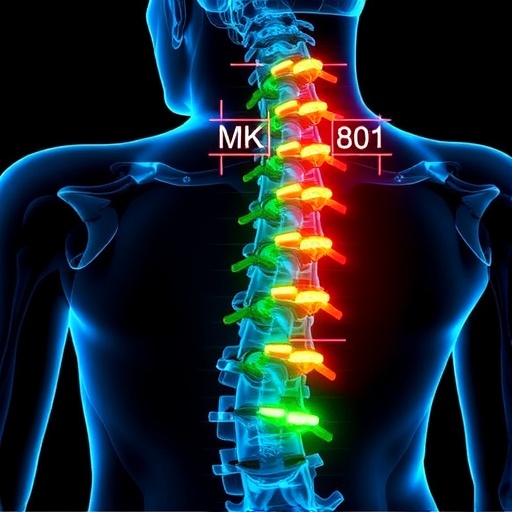In recent years, the quest to better understand and treat spinal cord injuries has garnered significant attention within the scientific community. These injuries often result from trauma and can lead to life-changing consequences, including paralysis and loss of sensory function. Among the various pharmacological interventions being explored, MK801, a potent NMDA receptor antagonist, has emerged as a focal point in preclinical studies.
In a groundbreaking study published in BMC Neuroscience, researchers led by Esposito, Paterniti, and Mazzon examined the effects of MK801 in a mouse model of spinal cord trauma. Utilizing a compression injury model, the team aimed to investigate not just the immediate impact of such injuries, but also the potential for MK801 to mitigate secondary damage that frequently complicates recovery. Secondary injury, a cascade of biochemical events that exacerbate initial trauma, has long been recognized as a significant barrier to effective recovery.
The study revealed that MK801 significantly attenuated secondary injury markers in treated mice compared to untreated controls. This attenuation was quantified through various means, including histological analysis and behavioral assessments. The researchers noted improved outcomes in locomotion and sensory functions, indicating that MK801 not only provides neuroprotection but also fosters some recovery of function post-injury. Such findings are pivotal, as they open avenues for further investigation in clinical settings.
One of the remarkable aspects of the study was its design; the authors employed a robust experimental approach, utilizing a well-established spinal cord injury model. This model simulates the mechanical and biological aspects of spinal trauma, allowing for accurate extrapolation of results. By embedding MK801 treatment within this framework, the research laid a solid foundation for future studies that could confirm its applicability in humans.
Moreover, the rationale behind using MK801 is underpinned by its pharmacological profile. As an NMDA antagonist, MK801 is capable of blocking excessive calcium influx into neurons, a process that can lead to excitotoxicity and, ultimately, cell death. By targeting this pathway, MK801 acts not only to protect neurons from dying but also to inhibit the inflammatory responses that can follow spinal injury, which further complicate recovery processes.
In addition to its neuroprotective properties, the study also raised important questions about the timing and delivery of MK801 in trauma scenarios. The brief window of opportunity for effective intervention following spinal cord injury is well-documented, highlighting the importance of developing timing protocols that can optimize therapeutic effects. The researchers advocate for future studies to delve deeper into the timing of MK801 administration, potentially leading to treatment regimens tailored for acute trauma settings.
Another noteworthy aspect is the potential for MK801 to inform the development of combination therapies. While MK801 demonstrated efficacy alone, the synergistic effects of combining it with other therapeutic agents could enhance its neuroprotective capabilities. Future research must explore such combinations, as polypharmacy could be the key to addressing the multifaceted nature of spinal cord injuries.
Notably, the findings of this research hold extensive implications not just for spinal cord injury treatments but also for broader neurotrauma applications. The mechanisms elucidated in this study extend beyond mere spinal injury. As evidence mounts regarding the utility of NMDA antagonists in various neurological conditions, it is vital that the scientific community remain vigilant in expanding this line of inquiry.
While the results are promising, it is also paramount to approach the future with caution. The transition from animal models to human applications poses numerous challenges, including variability in drug metabolism and the complex nature of human spinal cord injuries. Thus, additional clinical trials will be required to determine the efficacy and safety of MK801 in humans.
In summation, the advanced understanding of MK801’s role in attenuating secondary injury in spinal cord trauma presented by Esposito et al. represents a significant stride forward in neuroprotective strategies. The evidence from this study lays the groundwork for subsequent research, which could ultimately lead to enhanced therapeutic options for individuals suffering from spinal cord injuries. As the scientific community continues to explore this promising avenue, the hope remains that such pharmacological interventions will soon become optimized treatments that can significantly improve outcomes for affected patients.
Engaging with these findings, it is essential for researchers and clinicians alike to stay informed of ongoing studies related to MK801 and its applications. The momentum generated by such research could catalyze broader investments into the rehabilitation processes associated with spinal cord injuries. In conclusion, while many hurdles remain on the path to clinical application, the exploration of MK801 represents a beacon of hope for the future treatment of spinal cord injury.
Subject of Research: MK801 and its effect on secondary injury in spinal cord trauma.
Article Title: Retraction Note: MK801 attenuates secondary injury in a mouse experimental compression model of spinal cord trauma.
Article References: Esposito, E., Paterniti, I., Mazzon, E. et al. Retraction Note: MK801 attenuates secondary injury in a mouse experimental compression model of spinal cord trauma. BMC Neurosci 26, 28 (2025). https://doi.org/10.1186/s12868-025-00949-5
Image Credits: AI Generated
DOI: 10.1186/s12868-025-00949-5
Keywords: NMDA antagonist, spinal cord injury, MK801, neuroprotection, secondary injury, neurotrauma, preclinical studies, mouse model, pharmacological intervention.




